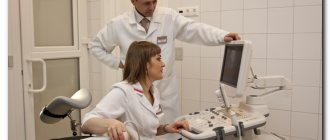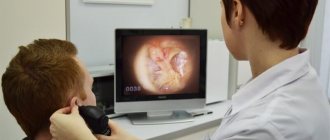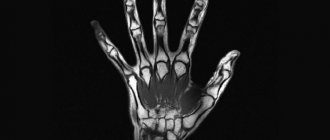If a woman has not performed an ultrasound examination of the fetus at an earlier stage, then an ultrasound scan at the 12th week of pregnancy becomes the first and takes on special significance.
The deadline already allows the mother to see the baby in its entirety, albeit only on the equipment monitor. And the doctor has the opportunity to evaluate the anatomical features of the fetus and tell the expectant mother about them. From a medical point of view, ultrasound screening at 12 weeks (1st trimester) is of considerable value for determining measures for further management of pregnancy and maintaining the health of the baby.
Indications
There are several reasons why an ultrasound examination of a pregnant woman at 12 weeks is of great importance:
- At this time, the age of the unborn child can be determined with high accuracy, and later he will gain weight, and the error in the date of conception will be significant (up to a week).
- At this time, it is important to determine the size of the collar area (the so-called soft tissues of the back of the head and neck). This indicator is key in the early diagnosis of chromosomal diseases, including Down, Patau, and Edwards syndromes. The examination must be carried out before 12 weeks , because after 14 weeks, chromosomal pathologies can no longer be detected and some fetal malformations too.
- Assessing the placenta insertion site, the presence of abruption, the quality and quantity of amniotic fluid are significant indicators of pregnancy that affect the health of the child and the management of pregnancy - they are also important to find out at 12 weeks.
- The doctor assesses the condition of the uterus - there should be no increased tone (that is, tension) or isthmic-cervical insufficiency. All these conditions require timely treatment, so high-quality and timely diagnosis during pregnancy plays a key role.
How does the baby develop?
Modern ultrasound examination allows the expectant mother to observe what is happening on the screen of the ultrasound machine along with the doctor. And the first examination becomes the first meeting between mother and son (or daughter).
Reference! Although it is still difficult to see the child in the usual sense on the monitor, women are excitedly waiting for this moment.
The most important thing at this stage is to make sure that everything is going as it should. And, of course, when the doctor says: “Listen to how the child’s heart beats. Here is the head, here are the legs, and here are the arms, all the fingers have already formed. Everything is fine with you,” mom feels a surge of happiness.
By 12 weeks of pregnancy, all the baby’s organs and body systems are fully formed.
Reference! The baby’s weight now is no more than 19 grams, and his body length is about 9 cm.
Despite its tiny parameters, a child’s brain is no different from the brain of an adult in anything except its size.
Often, on an ultrasound, a woman sees how the baby sucks his finger, and his nails are already formed. The chaotic movements of the baby are thought out by nature - during them he trains his muscular system.
Video
The ultrasound video below contains footage of the baby's activity in the womb at 12 weeks of pregnancy.
What will the study show?
What is an ultrasound at the 12th week of pregnancy in terms of information content, and what is looked at with its help? Ultrasound screening at 12 weeks of gestation allows the doctor to see and evaluate:
- the size of the unborn baby (the length of certain bones, body length and head parameters are recorded);
- symmetry of the brain hemispheres;
- location of the kidneys, stomach, heart and other important organs;
- possible developmental abnormalities, including heart defects, tumors, congenital anomalies;
- signs of genetic disorders;
- the place where the placenta is attached (normally it should be located along the anterior or posterior walls of the uterus);
- the condition of the umbilical cord, the presence and functioning of 2 arteries and a vein in it;
- the length of the cervix, which depends on the duration of pregnancy and the individual characteristics of the expectant mother;
- the exact date from the conception of the child.
How is it done?
The ultrasound examination procedure is performed transvaginally (by inserting a vaginal sensor) or transabdominally (through the abdominal wall).
And if the first method is common only at the beginning of pregnancy, when it is still difficult to obtain the necessary information through the abdominal wall, then the second method is used more widely .
However, there are indications for transvaginal ultrasound at a later date.
The study is performed transvaginally if:
- low position of the placenta or chorion is diagnosed;
- Isthmic-cervical insufficiency has been identified, the severity of which needs to be assessed;
- there are myomatous nodes;
- there are suspicions of inflammatory processes in cysts or appendages;
- There is a large layer of fatty tissue on the abdomen, through which it is not possible to see the necessary parameters.
Why do you need 2 screenings?
The second screening is not mandatory, but the information obtained from the examination is very valuable. Based on this, conclusions are drawn about the full development of the child. If the test results are negative, then the gynecologist can prescribe intrauterine treatment, additional examinations, or artificially induce premature birth. It is during this period that parents make a very important decision for themselves: whether to keep a potentially sick child or terminate the pregnancy.
Who is it prescribed to?
In our country, three times mandatory examination of all expectant mothers is regulated. It is carried out for preventive purposes and is called screening. A screening study makes it possible for early detection of perinatal pathology even in those pregnant women who are not worried about anything.
There are three such studies in total; they are prescribed at different stages of pregnancy and include ultrasound examination and determination of the biochemical composition of the blood. So an ultrasound at 12 weeks is indicated for all pregnant women, without exception.
If the results are bad
If the results of the first screening are not entirely favorable, do not immediately panic and get upset.
In addition to screening examinations, there are several other ways to determine fetal pathologies. After studying the screening results, if necessary, they are prescribed by a geneticist. And only after additional research can we talk about making a diagnosis.
In addition, to confirm or refute the results of the first screening examination, a second one is carried out at 16-20 weeks of pregnancy. After it is carried out, the situation will become more clear.
In any case, it is worth remembering that the results of the 1st screening are not the final verdict - it is only a relative assumption of further developments.
There is also always the possibility of obtaining erroneous research results, since each pregnant woman has her own individual characteristics, in which the results of tests and ultrasound may differ from normal, but the baby will be born absolutely healthy.
Will a woman find out the gender of her baby at 12 weeks?
It happens that already at the first screening, the mother finds out who is worth waiting for - a boy or a girl. The child’s genitals are already fully formed, but only a very experienced diagnostician can discern the baby’s gender. It often happens that the baby turns sideways or backwards and does not want to open up to the doctor. Do not worry if the first ultrasound does not clarify the sex of the unborn child - it will be determined at the next examination.
Functional diagnostic doctors have their own secrets for early recognition of the baby’s gender, because this information is very important for the mother. For example, when the child is positioned facing the sensor, the specialist can measure the angle formed by the baby’s back and the genital tubercle. If it is less than 30 degrees, there is a high probability that it will be a girl. An angle above the specified value indicates that a boy is expected.
Is it possible to find out at the first screening?
Screening is a special diagnostic method aimed at identifying pathologies in the unborn baby. The procedure is carried out in two stages: the use of ultrasound diagnostics and the collection of venous blood from the mother. Ultrasound diagnostics allows you to evaluate fetal development, defects and abnormalities. Even the absence of such results from an ultrasound does not guarantee the baby’s health. That is why, to obtain more accurate data, a biochemical blood test is additionally performed.
Initially, the study is scheduled for 11-13 weeks of pregnancy. Already at the first screening you can find out the sex of the child. However, experts do not give a guarantee.
For those parents who are wondering whether it is possible to find out the sex of the child at the first screening, it should be noted that even at the 13th week of gestation an incorrect result cannot be ruled out. The possibility of error is completely eliminated later - at the 17th week of pregnancy.
What is KTR?
One of the central indicators determined by ultrasound at 12 weeks is the coccygeal-parietal size of the embryo . During the first screening, normally it should be about 5.1-5.3 cm, fluctuations of a few tenths of a centimeter are acceptable. The doctor will clarify that the size of the KTP greatly depends on the exact stage of pregnancy. For example, at 11 weeks the CTE indicator will be approximately 4.2 cm (acceptable figures are from 3.4 to 5.0 cm).
The coccygeal-parietal size is a key factor in highly accurate determination of the gestational age, but only for a period of 7 to 16 weeks .
Important! Determining the gestational age using KTP is unique in that the error when using this method is no more than 3 days.
But after 16 weeks, the method loses its relevance and completely different parameters come to the fore.
The resulting indicators must correspond to the standard, which is determined using a special table. Based on a comparison of two indicators, the doctor draws conclusions about the well-being of the embryo and the compliance of its development with the established period.
At what time can the sex of a child be determined by ultrasound? Is the first screening reliable at 12 weeks?
Pregnancy is an exciting event for a woman. From the moment a new life is conceived, the body begins to rebuild. The expectant mother has many questions related to pregnancy, including at what weeks the baby’s sexual characteristics become visible. You can get answers to them from your doctor during your next screening in the ultrasound diagnostic room.
What determines the accuracy of determining the sex of a child during an ultrasound?
With the advent of ultrasound machines, married couples have the opportunity to find out the gender of the child before birth. However, this can only be done for a certain period of time. Over the course of 9 months, the expectant mother undergoes 3 scheduled ultrasounds:
- A study at 10-14 weeks allows us to identify the development of genetic pathologies and other dangerous diseases in the baby. The specialist takes appropriate measurements of the fetus, determines the heart rate and can tell the parents the sex of the child.
- At 20-24 weeks, the baby’s weight and size are measured. Based on the results, deviation or compliance with standards is established, and the presence or absence of dangerous pathologies is finally determined. At the second ultrasound, the sex of the child is determined with high accuracy.
- At 32-34 weeks, the doctor examines the correct location and functioning of the child’s internal organs. If, due to the location of the fetus, it was previously not possible to determine whether it was a son or a daughter, after the 3rd ultrasound the parents will most likely find out who they will have.
It is not always possible to recognize the sex of a child in the early stages. As the baby grows, all his organs become more visible, and the likelihood of accurately determining external sexual characteristics increases.
Sometimes the expectant mother does not know who she will have until the birth of her child. The accuracy of ultrasound results is influenced by several factors:
- the stage of pregnancy at which the study is carried out;
- technical characteristics of the device;
- professionalism of the specialist performing the procedure;
- location of the fetus in the uterine cavity.
Signs of fetal gender on ultrasound
Determining the sex of a child by ultrasound becomes possible after the fetus shows the corresponding signs. In boys it is the scrotum and penis, and in girls it is the labia.
The formation of the genitals in the fetus begins at 6-7 weeks of pregnancy. Until the 9th week, in both girls and boys, they have the appearance of a small genital tubercle, around which labioscrotal protuberances can be seen.
At week 11, boys develop a penis and scrotum. The testicles at this time have not yet descended and are in the tummy.
Starting from the 15th week, the doctor can quite accurately distinguish the genital organs and tell the mother the sex of the baby. The accuracy of the result may be affected by the following features of the development and location of the fetus:
- swelling of the labia, observed in girls during the formation of the genitals, and they resemble a penis in appearance;
- the location of the umbilical cord loop in such a way that it can be mistaken for the penis;
- When the legs are tightly clenched, the penis is not visible in boys, which leads to an error in determining gender.
However, there is a way to find out the sex of the child using an ultrasound, even if the anatomical features of the fetus do not allow this to be done visually. It consists of measuring the angle between the baby’s back and the genital tubercle. For girls, the angle is always less than 300 degrees, while for boys the corresponding figure is greater than or equal to this value. This method shows accurate results at 14 weeks of pregnancy.
What can prevent you from obtaining a reliable result?
Modern ultrasound equipment allows you to see the genitals of the unborn child quite accurately, the probability of error is 10%. The reasons for obtaining an unreliable result may be:
- Short gestation period. When turning to an ultrasound doctor with a request to determine the sex of the baby at the first screening, parents should understand that in the first months of pregnancy the genital organs are still forming, and it is not always possible to examine them.
- Baby's mobility in the last weeks before birth. During the examination, the child may turn around so that his genitals are not visible.
- Human factor. The ultrasound specialist may make a mistake with the conclusion due to his inexperience or other circumstances.
- Outdated or faulty equipment. High-precision studies are only possible with modern ultrasound machines. Ultrasonic sensors on long-life devices may fail.
At what time can the sex of the child be determined? Is the first screening informative?
The first study is carried out at 12-13 weeks. It is necessary to determine and evaluate:
- anatomical features in order to exclude genetic pathologies that appear in the early stages;
- markers of complex chromosomal abnormalities;
- condition of the uterine cavity, placenta, amniotic fluid.
Also, at 12 weeks, a multiple pregnancy can be detected if this could not be done earlier. Based on the results of the first ultrasound, the viability of the fetus and the compliance of its development with established standards are assessed.
Considering the fact that in the first months of pregnancy the genital organs are just forming, it is not always possible to determine the sex of the baby. In most cases, parents find out who they will have during the second planned ultrasound.
The likelihood of an accurate diagnosis depending on the timing of the ultrasound
Most parents want to find out the gender of their unborn child as early as possible and are wondering at how many months it can be determined. An ultrasound doctor can see obvious sexual characteristics only when the fetus has completed the formation of its genitals. This happens at 15 weeks.
If parents already received an answer to their question at the first screening, there is a possibility that at the next examination the result will be the opposite. The most accurate information is obtained at 20-24 weeks, when the likelihood of error is minimal. As confirmation, parents can receive a photo or video recording of an ultrasound examination.
In the last weeks before birth, the baby is already quite large and mobile, he can take positions in which the genitals are covered by the legs. In such cases, determining gender becomes difficult.
Is it possible to find out the sex of a child without an ultrasound?
Most often, future parents find out who will be born - a boy or a girl - after an ultrasound examination. However, several other methods are used in medical practice, the results of which can answer this question.
During pregnancy, many mothers feel who exactly will be born to them, and some rely on folk signs in this matter. There is also a known method for calculating the sex of a child, the result of which depends on the month in which he was conceived and how many full years the parents were at that time.
Alternative medical techniques
Invasive methods are used in isolated cases when the likelihood of developing some genetic pathology from the father or mother depends on the sex of the child. In this case, doctors use one of two methods:
- Chorionic villus sampling allows you to determine gender by examining a certain amount of uterine contents. To do this, a probe is inserted into the mother's vagina, with the help of which biological material is collected. The procedure is carried out at 3 months of pregnancy and gives a 100% result.
- Analysis of amniotic fluid can be carried out no earlier than 12 weeks. Amniotic fluid is collected for analysis using a syringe that is used to pierce the placenta. The result of the research cannot be wrong.
The decision about what analysis needs to be performed is made by the obstetrician-gynecologist. Since each procedure can have negative consequences, its use must be agreed upon with the expectant mother.
Another highly accurate alternative method for determining a baby’s gender is a DNA blood test. It can be carried out already in the first months of pregnancy. The study uses the mother's blood, which is taken from a vein. Parents are told the test results within 24 hours. The only drawback of this method is its high cost.
“Grandmother’s” methods of determining the sex of a child
There are several folk signs that can help an expectant mother find out the gender of her baby. You cannot rely on them entirely, but often the forecasts turn out to be correct. The most popular signs include the following:
- If pimples or pigmentation appear on a woman's face during pregnancy, she will give birth to a girl.
- Before the birth of her son, the mother’s skin condition improves and she looks attractive.
- If you constantly crave meat or salty foods, then a boy will be born. Mothers who prefer chocolate and other sweets should prepare for the birth of their daughter.
- An elongated abdomen is a sign of the birth of a son, and a round one is a sign of a daughter.
- Early toxicosis most often indicates the birth of a girl.
3D and 4D ultrasound – three-dimensional images for memory
More and more expectant mothers today prefer to replace conventional echography with 3D or 4D ultrasound. How are these methods better than traditional research? What is the difference between each other and what is given to future parents?
3D ultrasound allows you to get a three-dimensional image (photo), in which you can accurately see the baby’s face and examine the details of his appearance, find out the gender of the child and count his tiny fingers. The difference between a 3D examination and a traditional procedure is that it can only be carried out within a certain period of time - from 20 to 33 weeks and it is done only at the request of the parents, since from a medical point of view it is no different from a regular ultrasound, but costs several times more once.
4D differs from 3D only in the ability to see how a child lives in the womb in real time. Three-dimensional ultrasound shows only static frames, but four-dimensional, thanks to the rotation of the picture, allows you to see the baby’s movements and facial expressions.











